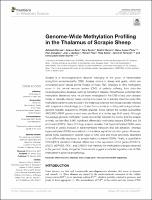Por favor, use este identificador para citar o enlazar este ítem:
https://repositorio.usj.es/handle/123456789/772
| Título : | Genome-Wide Methylation Profiling in the Thalamus of Scrapie Sheep |
| Autor: | Hernaiz, Adelaida

Sanz, Arianne 

Sentre, Sara Ranera, Beatriz 

López-Pérez, Óscar 

Zaragoza, Pilar 

Badiola, Juan J. 

Filali, Hicham 

Bolea, Rosa 

Toivonen, Janne Markus 

Martin-Burriel, Inmaculada 

|
| Palabras clave : | DNA methylation; Thalamus; Ovine scrapie; Prion; Whole genome bisulfite sequencing |
| Fecha de publicación: | 16-feb-2022 |
| Editorial : | FRONTIERS MEDIA SAAVENUE DU TRIBUNAL FEDERAL 34, LAUSANNE CH-1015, SWITZERLAND |
| Citación : | Hernaiz A, Sanz A, Sentre S, Ranera B, Lopez-Pérez O, Zaragoza P, Badiola JJ, Filali H, Bolea R, Toivonen JM and Martín-Burriel I (2022) Genome-Wide Methylation Profiling in the Thalamus of Scrapie Sheep. Front. Vet. Sci. 9:824677. doi: 10.3389/fvets.2022.824677 |
| Resumen : | Scrapie is a neurodegenerative disorder belonging to the group of transmissible spongiform encephalopathy (TSE). Scrapie occurs in sheep and goats, which are considered good natural animal models of these TSE. Changes in DNA methylation occur in the central nervous system (CNS) of patients suffering from prion-like neurodegenerative diseases, such as Alzheimer's disease. Nevertheless, potential DNA methylation alterations have not yet been investigated in the CNS of any prion disease model or naturally infected cases, neither in humans nor in animals. Genome-wide DNA methylation patterns were studied in the thalamus obtained from sheep naturally infected with scrapie at a clinical stage (n = 4) and from controls (n = 4) by performing a whole-genome bisulfite sequencing (WGBS) analysis. Ewes carried the scrapie-susceptible ARQ/ARQ PRNP genotype and were sacrificed at a similar age (4-6 years). Although the average genomic methylation levels were similar between the control and the scrapie animals, we identified 8,907 significant differentially methylated regions (DMRs) and 39 promoters (DMPs). Gene Ontology analysis revealed that hypomethylated DMRs were enriched in genes involved in transmembrane transport and cell adhesion, whereas hypermethylated DMRs were related to intracellular signal transduction genes. Moreover, genes highly expressed in specific types of CNS cells and those previously described to be differentially expressed in scrapie brains contained DMRs. Finally, a quantitative PCR (qPCR) validation indicated differences in the expression of five genes (PCDH19, SNCG, WDR45B, PEX1, and CABIN1) that matched the methylation changes observed in the genomic study. Altogether, these results suggest a potential regulatory role of DNA methylation in prion neuropathology. |
| URI : | https://repositorio.usj.es/handle/123456789/772 |
| ISSN : | 2297-1769 |
| Aparece en las colecciones: | Artículos de revistas |
Ficheros en este ítem:
| Fichero | Descripción | Tamaño | Formato | |
|---|---|---|---|---|
| Genome Wide Methylation Profiling.pdf | 2,26 MB | Adobe PDF |  Visualizar/Abrir |
Este ítem está sujeto a una licencia Creative Commons Licencia Creative Commons

